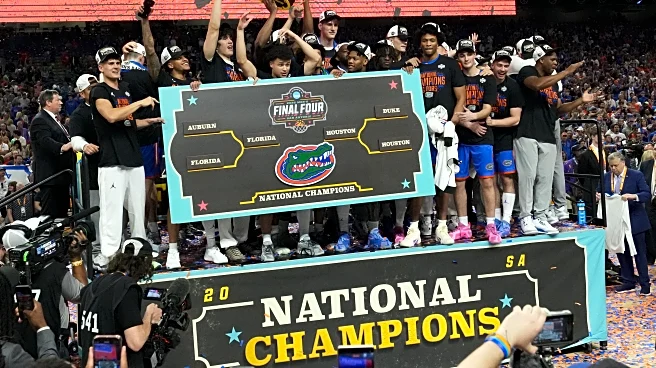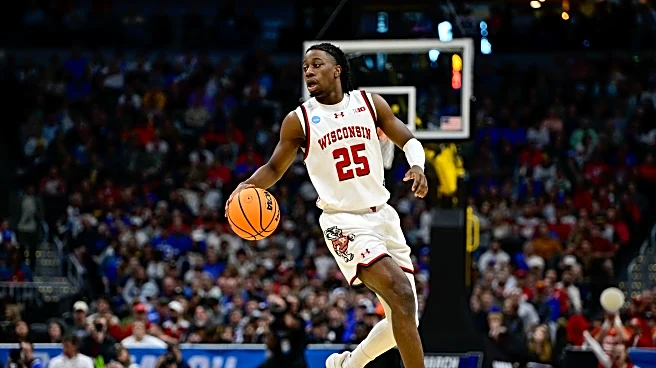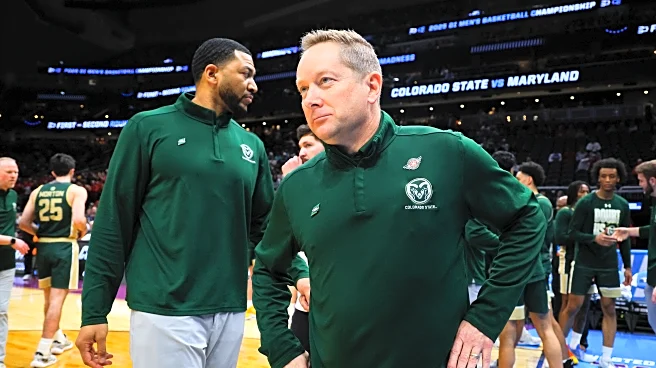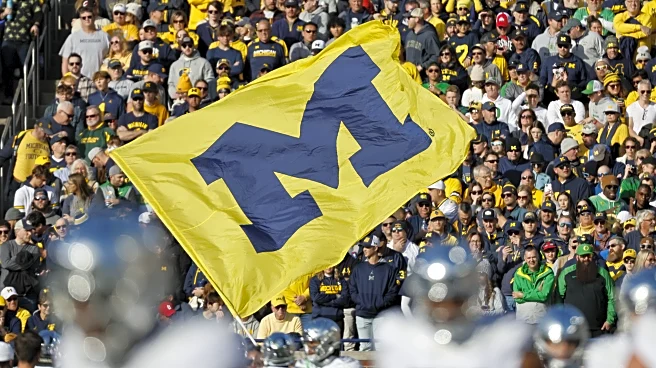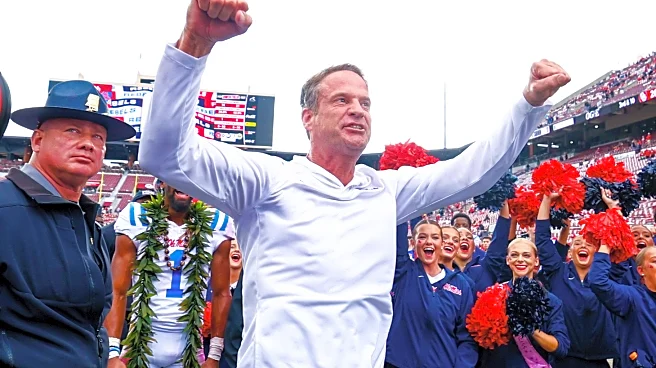The B1G is once again at the forefront of the men’s college basketball world. Before last season started, I described the B1G as the “bubbliest conference in the country.” Eight teams (Illinois, Maryland,
Michigan, Michigan State, Oregon, Purdue, UCLA and Wisconsin) ended up making the NCAA Tournament, but all eight of those teams were somewhere between a No. 2 seed and a No. 7 seed and all eight teams won at least one game in the NCAA Tournament. The NCAA Tournament performance by the conference as a whole was solid, but expectations are higher across the board this season.
Heading into the first week of the season, I have 11 B1G teams in the projected tournament field, trailing only the 12 projected SEC teams in the field (the SEC sent a whopping 14 teams dancing last season). But last season, the Big Ten had some of the biggest late-season risers (Maryland and Michigan State, for example), alongside some of the biggest late-season fall-offs (looking at you, Ohio State and Nebraska). Despite currently having no teams on the bubble (almost the polar opposite of last preseason), keep in mind that things can change quickly.
Purdue – No. 1 Seed (No. 3 overall)
Last Season: 24-12 (13-7 B1G, T-4th), Big Ten Tournament quarterfinalist, No. 4 seed in the NCAA Tournament, lost 62-60 to Houston in the Sweet Sixteen
Purdue focused on player retention in the offseason, and that focus was the right approach. Unanimous AP Preseason All-American Braden Smith (15.8 PTS, 8.7 AST, 4.5 REB) and his pick-and-roll partner Trey Kaufman-Renn (20.1 PTS, 6.5 REB, 2.2 AST) are back with elite third option Fletcher Loyer (13.8 PTS). Don’t forget wing contributors like C.J. Cox (6.0 PTS, 2.8 REB) either. The Boilermakers took an extra leap in the offseason from great to elite with added production coming from South Dakota State transfer forward Oscar Cluff (17.6 PTS on 63.4% FG, 12.3 REB and 2.8 AST) and 7-foot-4 center Daniel Jacobsen, who started Purdue’s season-opener and contributed 13 points, seven rebounds and three blocks before suffering a season-ending injury in the Boilermakers’ second game. That mix of amazing returners and new pieces (not to mention first-years Omer Mayer or Antione West Jr.) should lead Purdue to a return to dominance atop the Big Ten.
Michigan – No. 2 Seed (No. 5 overall)
Last Season: 27-10 (14-6 B1G, T-2nd), Big Ten Tournament champions, No. 5 seed in the NCAA Tournament, lost 78-65 to Auburn in the Sweet Sixteen
Dusty May’s first year leading the Wolverines was a great season, but this Michigan roster is on another level. Yaxel Lendeborg was the top-rated transfer (17.7 PTS, 11.4 REB, 4.2 AST, 1.8 BLK, 1.7 STL at UAB), and one of two B1G players on the AP Preseason All-American team, joining Purdue’s Smith. While Lendeborg is the headliner of Michigan’s haul, the Wolverines have the second-ranked overall transfer portal class, with three major pieces – Morez Johnson Jr. (7.0 PTS, 6.7 REB, 1.1 BLK at Illinois), Elliot Cadeau (9.4 PTS, 6.2 AST, 2.9 REB at North Carolina) and Aday Mara (6.4 PTS, 4.0 REB, 1.6 BLK at UCLA) – also transferring in. Will Tschetter (6.4 PTS, 2.4 REB, 35.1% 3PT), Nimari Burnett (9.4 PTS, 3.5 REB, 40.0% 3PT) and Roddy Gayle Jr. (9.8 PTS, 3.4 REB, 2.2 AST) are returners steadying the ship, while Michigan Mr. Basketball (and No. 18 recruit) Trey McKenney will step in and have an immediate impact for the Wolverines.
Illinois – No. 4 Seed (No. 13 overall)
Last Season: 22-13 (12-8 B1G, T-7th), Big Ten Tournament quarterfinalist, No. 6 seed in the NCAA Tournament, lost 84-75 to Kentucky in the Second Round
The Fighting Illini are tasked with rebuilding much of their roster for the second season in a row, as they lost five of their top eight scorers from last season. However, Illinois kept Tomislav Ivisic (13.0 PTS, 7.7 REB, 2.3 AST), Kylan Boswell (12.3 PTS, 4.8 REB, 3.4 AST), Ben Humrichous (7.6 PTS, 3.8 REB) and Jake Davis (3.0 PTS in 9.5 MIN) from last year’s roster, and re-integrating Ty Rodgers (6.2 PTS in ‘23-24) into the fold shouldn’t be a big challenge. It is also bringing in transfers Zvonimir Ivisic (8.5 PTS, 4.3 REB, 1.9 BLK at Arkansas) and Andrej Stojakovic (17.9 PTS, 4.7 REB at Cal) to reinforce that experienced core. With four good first-years also joining the program, Illinois should compete near the top of the conference once again.
UCLA – No. 4 Seed (No. 16 overall)
Last Season: 23-11 (13-7 B1G, T-4th), Big Ten Tournament quarterfinalist, No. 7 seed in the NCAA Tournament, lost 67-58 to Tennessee in the Second Round
UCLA has a rare combination in the current era of college basketball: three of its top four scorers from last season (Tyler Bilodeau, Eric Dailey Jr. and Skyy Clark) are back on the roster. The Bruins also added 2024-25 MWC Player of the Year Donovan Dent (20.4 PTS, 6.4 AST, 1.4 STL at New Mexico) in the transfer portal to give a much-needed boost to an offense that was sometimes a tough watch last season. In addition to Dent, Jamar Brown (17.0 PTS, 7.4 REB at University of Missouri-Kansas City), Xavier Booker (4.7 PTS, 2.2 REB at Michigan State), Steven Jamerson II (10.0 PTS, 7.8 REB at San Diego) and Anthony Peoples Jr. (5.0 PTS, 2.4 REB) all join the Bruins from the transfer portal. The Bruins were anchored by experience and defense last year, and considering they only added one first-year to the roster (Markell Alston), the formula in Westwood is similar this season.
Michigan State – No. 5 Seed (No. 19 overall)
Last Season: 30-7 (17-3 B1G, 1st), Big Ten Tournament semifinalist, No. 2 seed in the NCAA Tournament, lost 70-64 to Auburn in the Elite Eight
It feels wrong to have Michigan State this low after a dominant season. However, the Spartans are grappling with the losses of Jase Richardson, Xavier Booker, Frankie Fidler, Szymon Zapala and most importantly, Jaden Akins, as well as Tre Holloman transferring out. But Michigan State is as consistent as any program in college basketball. Coen Carr, Jaxon Kohler, Carson Cooper and Jeremy Fears Jr. are all ready to take the necessary leaps to lead this Spartans squad to a successful season. Holloman was an obvious candidate to be the lead guard for Michigan State this season, but Fears Jr. already shared that role with him last year. Expect a sophomore breakout from Kur Teng to raise the Spartans’ ceiling. Head coach Tom Izzo’s bunch also added two high four-star first-years, Cam Ward and Jordan Scott, and turned to the transfer portal to add Miami’s Divine Ugochukwu (5.3 PTS, 1.9 2.3 AST) and Samford’s Trey Fort (14.6 PTS, 4.0 REB).
Wisconsin – No. 6 Seed (No. 24 overall)
Last Season: 27-10 (13-7 B1G, T-4th), Big Ten Tournament runner-up, No. 3 seed in the NCAA Tournament, lost 91-89 to BYU in the Second Round
The Badgers flew under the radar during the 2024-25 preseason, but quickly surged into the upper echelon of the B1G behind John Tonje’s stellar season. Wisconsin might not have a transfer with a Tonje-level impact, but this year’s transfer class has plenty of versatility and experience. Those five transfers are Nick Boyd (13.4 PTS, 3.9 REB, 3.9 AST at San Diego State), Austin Rapp (13.8 PTS, 6.5 REB, 2.5 AST at Portland), Andrew Rohde (9.3 PTS, 2.9 REB, 4.3 AST) and Braeden Carrington (7.4 PTS, 4.8 REB, 1.7 AST at Tulsa). Meanwhile, John Blackwell (15.8 PTS, 5.1 REB, 2.2 AST) and Nolan Winter (9.4 PTS, 5.8 REB) will have elevated roles in the Badgers’ offense this season, and if those two can thrive, Wisconsin will cruise to its fifth NCAA Tournament appearance in the last six seasons.
Oregon – No. 7 Seed (No. 25 overall)
Last Season: 25-10 (12-8 B1G, T-7th), Big Ten Tournament quarterfinalist, No. 5 seed in the NCAA Tournament, lost 87-83 to Arizona in the Second Round
The Ducks have a great returning core led by 2025-26 Preseason All-Big Ten Team selections Nate Bittle and Jackson Shelstad. In addition to those two, Kwame Evans Jr. (6.1 PTS, 4.6 REB in 16.3 MIN) returns to add more depth to the frontcourt. Oregon brought in Sean Stewart (5.7 PTS, 5.8 REB at Ohio State), Devon Pryor (3.2 PTS at Texas) and Takai Simpkins (16.4 PTS, 3.1 REB, 2.6 AST at Elon) from the transfer portal. The most interesting additions for Oregon, though, are big man Ege Demir, who played for Darüssafaka Lassa in Turkey, and Wei Lin, who averaged 21.0 PTS, 5.0 AST and 3.3 REB in the Chinese Basketball Association last season. To put Lin’s numbers in a more familiar context, Lin scored more than former NBA veterans like Trey Burke, Will Barton, Eric Bledsoe and Jared Sullinger, and also more than Yang Hansen, who was selected with the 16th overall pick in the NBA Draft last season. How Demir and Lin’s play will translate into the B1G remains to be seen, but Oregon has a strong foundation with Bittle and Shelstad regardless.
USC – No. 8 Seed (No. 29 overall)
Last Season: 17-18 (7-13 B1G, T-12th), Big Ten Tournament second round appearance, lost 60-59 to Villanova in the quarterfinals of the College Basketball Crown
The Trojans completely underperformed relative to expectations last season and brought in a litany of fresh faces to try to turn around the program. USC went all-in on the transfer portal in the offseason, bringing in nine transfers, compared to just two first-years (although both of those first-years are top-60 recruits). Headlining that transfer group are Auburn transfer Chad Baker-Mazara (12.3 PTS, 3.0 REB. 2.1 AST), who was a key contributor to the Tigers’ Final Four run, and Maryland transfer Rodney Rice (13.8 PTS, 2.2 REB, 2.1 AST). In addition to those two, the Trojans also added Ezra Ausar (Utah), Gabe Dynes (Youngstown State), Jacob Cofie (Virginia), Amarion Dickerson (Fairleigh Dickinson), Jaden Brownell (Samford), Jordan Marsh (UNC-Asheville) and EJ Neal Jr. (Sacramento State). With that massive infusion of talent in L.A., Eric Musselman seems to have a squad that can bring USC to its first NCAA Tournament since it made three straight from 2021-2023.
Ohio State – No. 8 Seed (No. 30 overall)
Last Season: 17-15 (9-11 B1G, 10th), Big Ten Tournament first round appearance, no postseason tournament participation
The Buckeyes crashed and burned in the final part of last season, stumbling to 17-15 after a decent 15-10 start. The good news for fans is that Ohio State has another year of 2025-26 Preseason All-Big Ten Team selection Bruce Thornton (17.7 PTS, 3.4 REB, 4.6 AST) and John Mobley Jr. (13.0 PTS, 1.5 REB, 2.2 AST) leading the backcourt. Devin Royal (13.7 PTS, 6.9 REB) also returns to the Buckeyes, meaning Ohio State has a solidified big three heading the roster. Supplementing them will be top-50 recruit Amare Bynum and four new transfers. Namely, big men Christoph Tilly (12.5 PTS, 4.9 REB at Santa Clara), Josh Ojianwuna (7.4 PTS, 6.4 REB at Baylor) and Brandon Noel (19.0 PTS, 7.7 REB at Wright State) are joined by former Indiana guard Gabe Cupps. If the four additions to the frontcourt succeed, Thornton, Mobley and Royal will produce more than enough scoring to lead the Buckeyes to the NCAA Tournament.
Indiana – No. 8 Seed (No. 32 overall)
Last Season: 19-13 (10-10 B1G, 9th), Big Ten Tournament second round appearance, no postseason tournament participation
The Hoosiers brought in Darian DeVries to completely change the culture of a program that experienced too much mediocrity over the previous few years to satisfy fans with extremely high expectations. DeVries made an immediate impact on his way to Bloomington, bringing in ten transfers in a class that ranks in the top ten in the country. Headlining the class are Darian’s son, Tucker DeVries (21.6 PTS, 6.7 REB, 3.7 AST at Drake in ‘23-24), Sun Belt Player of the Year Tayton Conerway (14.2 PTS, 4.6 REB, 4.8 AST at Troy), All-Atlantic 10 First Team selection Reed Bailey (18.8 PTS, 6.1 REB, 3.8 AST at Davidson) and All-Conference USA First Team selection Lamar Wilkerson (20.5 PTS, 4.0 REB, 2.1 AST at Sam Houston State), but players like Conor Enright (Drake), Jasai Miles (North Florida) and Nick Dorn (Elon) are also ready to help the Hoosiers out. It’s a lot to ask for an NCAA Tournament appearance in a coach’s first season with a program, but DeVries and Indiana could be on a similar path to the one May and Michigan went on last season.
Iowa – No. 9 Seed (No. 33 overall)
Last Season: 17-16 (7-13 B1G, T-12th), Big Ten Tournament second round appearance, no postseason tournament participation
Speaking of new head coaches, Ben McCollum joins the Hawkeyes after spending just one season at Drake. McCollum’s Bulldogs went 31-4 with an appearance in the Round of 32 of the NCAA Tournament, and McCollum will bring five players from his eight-man Drake rotation with him to Iowa. Most importantly, the head coach convinced 2025-26 Preseason All-Big Ten Team selection Bennett Stirtz (19.2 PTS, 4.3 REB, 5.7 AST at Drake) to come with him to Iowa City. In addition to those five, the Hawkeyes are adding sharpshooter Brendan Hausen (10.9 PTS, 2.5 REB at Kansas State) and Horizon League Player of the Year Alvaro Folgueiras (14.1 PTS, 9.1 REB, 3.2 AST at Robert Morris) to the fold. McCollum has multiple options to fill out his rotation outside of those seven transfer portal additions, but with a top-ten portal class, Iowa should be a tournament team this year.
Washington – First Four Out
Last Season: 13-18 (4-16 B1G, 18th), missed Big Ten Tournament, no postseason tournament participation
The Huskies are ready to break out of the basement of the B1G standings this season. Washington completely changed the complexion of its roster, and it looks like it worked. The Huskies added three four-star recruits (JJ Mandaquit, Jasir Rencher and Courtland Muldrew), former Maryland and Frank Phillips College big man Mady Traore and international standouts Hannes Steinbach and Nikola Dzepina. And despite those additions giving Washington a top-15 recruiting class, the Huskies’ transfers are even more impressive. Washington brings in Atlantic Sun Player of the Year Jacob Ognacevic (20.0 PTS, 8.0 REB, 1.4 AST at Lipscomb), SoCon Player of the Year Quimari Peterson (19.5 PTS, 4.5 REB, 3.7 AST at East Tennessee State), as well as the former USC backcourt duo of Wesley Yates III (14.1 PTS, 2.9 REB, 1.8 AST) and Desmond Claude (15.8 PTS, 3.5 REB, 4.2 AST), former five-star Indiana commit Bryson Tucker and Lathan Sommerville (8.2 PTS, 4.1 REB at Rutgers). There is simply too much talent on this roster for the Huskies not to at least be a part of the bubble conversation, and they could easily climb higher.
Nebraska – In Consideration
Last Season: 21-14 (7-13 B1G, T-12th), missed Big Ten Tournament, College Basketball Crown champions
The Cornhuskers started 12-2, then lost six in a row, won four in a row and finally lost six of their last seven (including five straight) to end the season. And of course, as the streakiest team in the country, after losing the last five games of the regular season and missing the Big Ten Tournament, Nebraska finished the season with four straight victories to win the inaugural College Basketball Crown championship. After a wildly inconsistent season, the Cornhuskers turned to familiar faces from the past to bring stability to their roster, getting Rienk Mast (12.3 PTS, 7.5 REB, 3.0 AST in ‘23-24) back from injury and Jamarques Lawrence (6.9 PTS, 3.1 REB, 2.5 AST in ‘23-24) back after he transferred to Rhode Island last season. In addition to those two, Connor Essegian (10.7 PTS, 2.8 REB), Berke Büyüktuncel (6.0 PTS, 5.5 REB) and Sam Hoiberg (3.9 PTS, 1.4 STL) are all back on the roster again. Those five are joined by a transfer class headlined by Pryce Sandfort (8.8 PTS, 2.9 REB at Iowa) to form a roster with great depth and experience, and should be in play for an NCAA Tournament appearance.
Maryland – In Consideration
Last Season: 27-9 (14-6 B1G, T-2nd), Big Ten Tournament semifinalist, No. 4 seed in the NCAA Tournament, lost 87-71 to Florida in the Sweet Sixteen
After a messy ending to the Kevin Willard era, the Terrapins are hoping for a great first season under Buzz Williams. But Williams needed three seasons to make his first NCAA Tournament at Virginia Tech, and four seasons to do the same at Texas A&M, so I am urging patience with Maryland this season. One factor that could be very important in allowing Williams to turn around that trend is that he brings Pharel Payne (10.4 PTS, 5.1 REB), Solomon Washington (4.7 PTS, 5.1 REB), George Turkson Jr. (DNP) and Andre Mills (DNP) from his Aggies roster last season to establish his program culture anew in College Park. Along with those four, the Terrapins are adding Myles Rice (10.1 PTS, 2.8 REB, 2.8 AST at Indiana), Elijah Saunders (10.4 PTS, 5.0 REB at Virginia), Isaiah Watts (11.0 PTS, 3.7 REB, 2.1 AST at Washington State), David Coit Jr. (5.1 PTS, 1.5 REB, 1.3 AST at Kansas) and Rakease Passmore (0.7 PTS in 5.0 MIN at Kansas) from the portal. Maryland has a ton of experience on its roster, and if the Terps gel early in the season, they will be a factor in the bubble picture.
Northwestern – Out
Last Season: 17-16 (7-13 B1G, T-12th), Big Ten Tournament second round appearance, no postseason tournament participation
The Wildcats had a roster decimated by injuries last season, as Northwestern was without Jalen Leach and Brooks Barnhizer down the stretch. The ‘Cats are hoping to have better injury luck, and also hoping for a few first-year players to break out. Northwestern brought in a top-30 high school recruiting class, which featured five players, including four-star Tre Singleton — the highest-rated player to ever sign with Northwestern, according to 247Sports. The ‘Cats also added three players through the transfer portal, namely Jayden Reid (12.6 PTS, 3.6 AST at USF), Arrinten Page (3.5 PTS, 2.3 REB at Cincinnati) and Patriot League Freshman of the Year Max Green (14.9 PTS, 5.6 REB, 3.5 AST at Holy Cross). Northwestern’s premier piece is returner Nick Martinelli (20.5 PTS, 6.2 REB, 1.7 AST), but replacing the production of Barnhizer and Leach, as well as veterans Ty Berry and Matthew Nicholson, will be a massive challenge. If the Wildcats are going to work their way onto the bubble over the course of the season, all eight of Northwestern’s new players will need to score at a high enough level to take defensive attention away from just Martinelli.
Minnesota – Out
Last Season: 15-17 (7-13 B1G, T-12th), Big Ten Tournament first round appearance, no postseason tournament participation
The Golden Gophers are one of the many teams in the B1G that had to make complete roster overhauls with new coaches. Niko Medved comes over from Colorado State to take over a program that hasn’t made the NCAA Tournament since 2019. Despite bringing in a large group of transfers, the quality of those players isn’t quite as high as the other portal classes in the conference, as Minnesota’s transfer class ranks 50th in the country. From a statistical perspective, BJ Omot (16.7 PTS, 4.2 REB, 1.4 AST at North Dakota in ‘23-24), Bobby Durkin (13.5 PTS, 5.9 REB, 2.4 AST, 1.3 STL at Davidson), Chansey Willis Jr. (16.8 PTS, 4.3 REB, 5.8 AST, 1.7 STL at Western Michigan) and Cade Tyson (16.2 PTS, 5.9 REB, 1.6 AST at Belmont in ‘23-24) are the four most highly-anticipated additions, but all of Minnesota’s transfers will need to produce for this team to have any chance to go to the big dance.
Rutgers – Out
Last Season: 15-17 (8-12 B1G, 11th), Big Ten Tournament first round appearance, no postseason tournament participation
The Scarlet Knights brought in two of the top three high school recruits (Ace Bailey and Dylan Harper) in the country last season and still finished below .500 overall and in conference. Rutgers showed flashes of competitiveness but lacked consistency, and many of the best pieces on last season’s roster won’t be sticking around to continue that consistency. Bailey and Harper are both in the NBA now, while Lathan Sommerville and Jeremiah Williams transferred to Washington and Georgetown, respectively. Dylan Grant (5.9 PTS, 3.4 REB), Jamichael Davis (4.6 PTS) and Emmanuel Ogbole (3.1 PTS, 3.7 REB) are all back, but having less than 15 points per game among core returners is a bad situation for a team integrating seven first-years into the roster. Transfers Darren Buchanan Jr. (10.8 PTS, 5.8 REB, 2.1 AST at George Washington), Baye Fall (2.5 PTS at Kansas State) and Tariq Francis (19.2 PTS, 4.3 REB, 3.6 AST at NJIT) give the Scarlet Knights some experience, but not enough to expect much out of this team.
Penn State – Out
Last Season: 16-15 (6-14 B1G, 17th), missed Big Ten Tournament, no postseason tournament participation
The only team that finished lower in the conference standings last year was Washington, and unfortunately for the Nittany Lions, the talent brought in to replace a squad that already struggled to win games wasn’t nearly enough to expect a better season right away. Penn State did bring in a top-25 overall high school class, including top-40 recruit Kayden Mingo, but with only two transfers — Cincinnati’s Josh Reed (4.8 PTS, 2.5 REB) and UIC’s Saša Ciani (9.9 PTS, 7.6 REB) — it’s unlikely that this future-focused roster will be a very competitive one in a stacked conference. On the bright side, Penn State kept Freddie Dilione V (9.4 PTS, 2.8 REB, 1.7 AST), Dominick Stewart (2.8 PTS, 1.1 REB) and Eli Rice (only played one game as a first-year last season), but again, that won’t be enough to replace the five double-figure scorers (Ace Baldwin Jr., Yanic Konan Niederhauser, Zach Hicks, Nick Kern Jr. and Puff Johnson) that left the program after last season.


